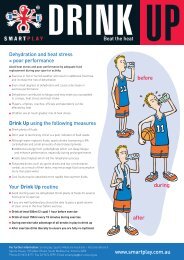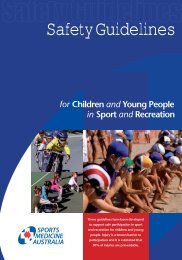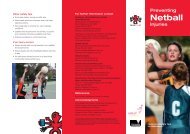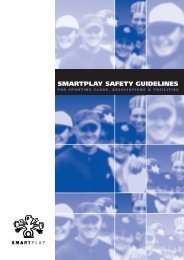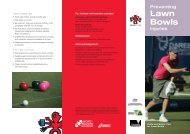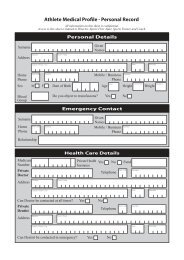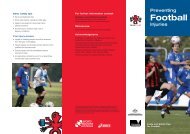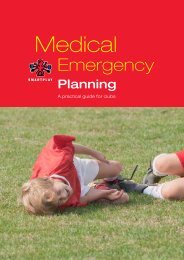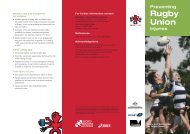Preventing Injuries Basketball.pdf - Smartplay
Preventing Injuries Basketball.pdf - Smartplay
Preventing Injuries Basketball.pdf - Smartplay
You also want an ePaper? Increase the reach of your titles
YUMPU automatically turns print PDFs into web optimized ePapers that Google loves.
Facts on basketball injuries<br />
<strong>Basketball</strong> is one of the most popular sports in<br />
Australia with players of all ages and skill<br />
levels participating.<br />
Statistics from the Australian Sports Commission’s<br />
2004 survey showed an estimated 508,000<br />
Australians aged 15 years and older played<br />
basketball in the 12-month period prior to<br />
being surveyed.<br />
<strong>Basketball</strong> is a dynamic game of speed with<br />
frequent and aggressive body contacts that can<br />
result in injury.<br />
How many injuries?<br />
• From 2002-2004, basketball injury statistics recorded<br />
907 Victorian hospital admissions and 3,426<br />
emergency department presentations.<br />
• From 2002-2003, one in every 523 basketballers was<br />
admitted to a Victorian hospital.<br />
• The rate of injury for basketballers is 14 injuries per<br />
1,000 hours played.<br />
The causes and types of injuries<br />
• Common causes of injuries are falls, player contact,<br />
awkward landings, abrupt changes in direction and<br />
being hit by the ball.<br />
• <strong>Injuries</strong> to the lower body, namely ankle sprains, are<br />
most common.<br />
• Previous ankle injury, wearing shoes with air cells in the<br />
heel and not stretching during warm up increases your<br />
risk of ankle injury.<br />
• <strong>Injuries</strong> to the hand, fingers, head, face and teeth are<br />
also common.<br />
• Knee injuries account for the most time lost in training<br />
and games.<br />
• Females are at higher risk of knee injury than males.<br />
• Overuse injuries are most common in higher level<br />
players due to the duration and intensity of play.<br />
Safety tips for basketballers<br />
Good preparation is important<br />
• Undertake training prior to competition to ensure<br />
readiness to play.<br />
• Always warm up, stretch and cool down.<br />
• Undertake fitness programs to develop strength,<br />
balance, coordination and flexibility.<br />
• Gradually increase the intensity and duration of<br />
training as this will help reduce the risk of injury.<br />
Good technique and practices<br />
will help prevent injury<br />
• Know the rules and play fairly.<br />
• Learn and practise correct passing, jumping, landing<br />
and shooting techniques.<br />
• Be aware of the dangers of using basketball<br />
equipment inappropriately.<br />
• Know your physical capabilities and choose activities<br />
appropriate to your fitness level.<br />
• Coaches and officials should undertake regular<br />
certification and education to ensure their injury<br />
prevention knowledge is kept up-to-date.<br />
• Officials should enforce game rules.<br />
Wear the right protective equipment<br />
• Wear a mouthguard, preferably custom-fitted,<br />
at all times.<br />
• Wear shoes designed specifically for basketball.<br />
• Consider preventive ankle bracing if involved in<br />
jumping and rebounding frequently or if you have<br />
a history of ankle injury.<br />
Check basketball environment<br />
for hazards<br />
• Check and maintain the playing surface to remove<br />
hazards e.g. stones, wet surfaces.<br />
• Backboards and baskets should be of a high<br />
standard and securely mounted.<br />
• Backboards, their supports and walls should be<br />
suitably padded.<br />
• Baskets and boundary lines should not be<br />
too close to walls and fixtures. Refer to FIBA<br />
rules at www.basketballvictoria.com.au for<br />
further information.<br />
• If installing a ring at home ask a suitably qualified<br />
person such as a building professional to assess<br />
the safety of your installation.<br />
• Do not fix a basketball ring or backboard<br />
to brickwork.<br />
Modify rules and equipment<br />
for children<br />
• Juniors should be matched for competition on<br />
physical maturity and skill level.<br />
• Encourage children to take part in Aussie Hoops<br />
Oz Ball and Skill, Fun & Play programs, as<br />
well as the McDonald’s ® Hoop Time program<br />
to develop good skills and techniques.<br />
Photograph provided by <strong>Basketball</strong> Australia



